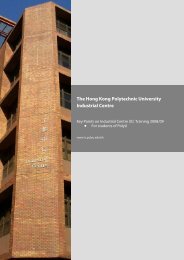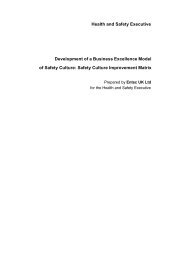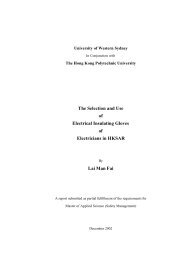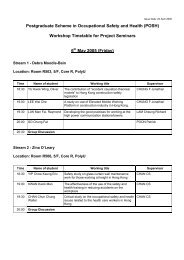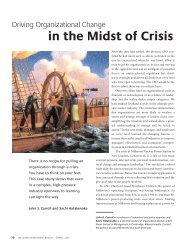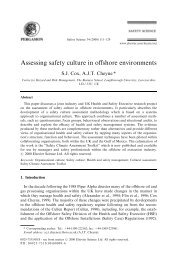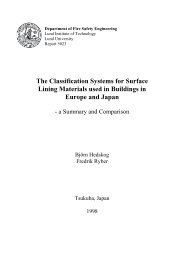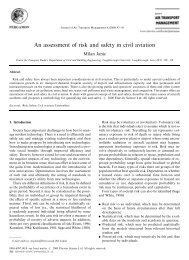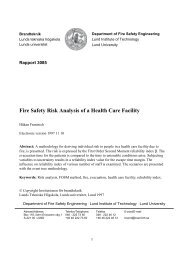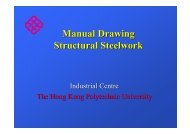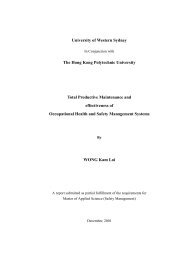Safety culture: transferring theory and evidence ... - Industrial Centre
Safety culture: transferring theory and evidence ... - Industrial Centre
Safety culture: transferring theory and evidence ... - Industrial Centre
- No tags were found...
Create successful ePaper yourself
Turn your PDF publications into a flip-book with our unique Google optimized e-Paper software.
Behavioural Research in Road <strong>Safety</strong>: 10th SeminarIn the case of the Shuttle the warnings of danger, which were recognised <strong>and</strong> taken veryseriously by many of those involved, were rarely equivocal: some were weak in theirimplications; others gave mixed messages about safety; <strong>and</strong> still others were embedded inconsiderable noise. Vaughan’s account shows how the significance of the available warningsfor flight safety, <strong>and</strong> the norms though which the risk was judged, were accordinglycontinually negotiated <strong>and</strong> re-negotiated through the working practices of the teams ofengineers. This worked well in resolving many of the safety problems with the Shuttle, butfor the O-ring seals a cycle of decision making was set in motion where signals of the‘deviant’ behaviour of the system were successively ‘normalised’ as acceptable through thest<strong>and</strong>ard process of risk assessment institutionalised in the working practices of theorganisations. This process Vaughan terms the ‘normalisation of deviance’ <strong>and</strong> it wasrepeated throughout the history of the joint problems. By deconstructing the notions of‘safety norm’ <strong>and</strong> ‘violation’, it suggests also that attempts to investigate the micro-world oforganisational risk perception <strong>and</strong> decision making might take account of the dynamic waysin which risk is constructed by workgroups.Organisational sub-<strong>culture</strong>s<strong>Safety</strong> <strong>culture</strong> is often discussed as if it is a unified property that characterises anorganisation throughout. However, any large organisation, or set of co-operatingorganisations, will comprise different social sub-groupings (drivers <strong>and</strong> maintenance,production <strong>and</strong> managers, permanent staff <strong>and</strong> sub-contractors, site A compared to site B).For example, in aviation such sub-groupings are often associated with very differentattitudes towards safety (O’Leary <strong>and</strong> Pidgeon, 1994). Evidence for the existence of safetysub-<strong>culture</strong>s comes from studies in the workplace by Sinclair <strong>and</strong> Haines (1993), Gherardi,Nicolini <strong>and</strong> Odella (1996) <strong>and</strong> by Mearns et al (1998). The latter authors, in a large surveyof safety climate in offshore oil installations, note significant differences in attitudestowards safety between staff at different levels of the organisations studied (eg managers vsworkers), while far less differences between operators who were contractors compared tothose who were permanent staff. This latter finding might be explained by professional sub<strong>culture</strong>sshared across the industry (ie attached to specific roles or levels of training, <strong>and</strong>irrespective of the organisation you actually work for) or the influence of the safety sub<strong>culture</strong>son a particular platform in moulding the attitudes of everybody working there.They speculate that the absence of a unitary organisational <strong>culture</strong> may not necessarily be abad thing as ‘it may always require some dissenting voices in the crowd to continuallyimprove the state of safety’. In theoretical terms different sub-<strong>culture</strong>s might indeed be auseful counter to the dangers of corporate myopia (Pidgeon, 1998).Organisational learningThere are very few contemporary treatments of safety <strong>culture</strong> that do not accordconsiderable importance to the goal of learning from incidents, accidents <strong>and</strong> other relevantexperience through such things as monitoring, incident analysis <strong>and</strong> feedback systems, asone part of an integrated safety management system (eg ACSNI 1993; Toft <strong>and</strong> Reynolds,1997). Curiously, the related questions of organisational politics <strong>and</strong> power are absent inmost theoretical models of organisational failures <strong>and</strong> many discussions of safety <strong>culture</strong>stoo. We would argue that organisational politics <strong>and</strong> power are crucial for determiningwhether a number of the goals of a safety <strong>culture</strong> will be met, <strong>and</strong> in particular that oforganisational learning (see Pidgeon, 1997).56



